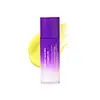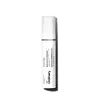What's inside
What's inside
 Key Ingredients
Key Ingredients

 Benefits
Benefits

 Concerns
Concerns

 Ingredients Side-by-side
Ingredients Side-by-side

Daucus Carota Sativa Root Extract
Skin ConditioningCentella Asiatica Extract
CleansingPanax Ginseng Extract
AntioxidantCaprylic/Capric Triglyceride
MaskingOleyl Erucate
EmollientGlycerin
HumectantHydroxypropyl Cyclodextrin
MaskingTriheptanoin
Skin ConditioningCetearyl Olivate
Sorbitan Olivate
EmulsifyingTocopheryl Acetate 1%
AntioxidantHydroxyethyl Acrylate/Sodium Acryloyldimethyl Taurate Copolymer
Emulsion StabilisingPentylene Glycol
Skin ConditioningPhospholipids 0.5%
Skin ConditioningPanthenol 0.5%
Skin ConditioningBetaine 0.5%
HumectantTocopherol 0.5%
AntioxidantRubus Chamaemorus Seed Oil
Skin ConditioningLecithin
EmollientBakuchiol 0.5%
AntimicrobialBiosaccharide Gum-1 0.3%
HumectantEctoin 0.3%
Skin ConditioningAllantoin 0.2%
Skin ConditioningPhenoxyethanol
PreservativeEthylhexylglycerin
Skin ConditioningRetinal 0.2%
Skin ConditioningCitric Acid
BufferingDisodium EDTA
Daucus Carota Sativa Root Extract, Centella Asiatica Extract, Panax Ginseng Extract, Caprylic/Capric Triglyceride, Oleyl Erucate, Glycerin, Hydroxypropyl Cyclodextrin, Triheptanoin, Cetearyl Olivate, Sorbitan Olivate, Tocopheryl Acetate 1%, Hydroxyethyl Acrylate/Sodium Acryloyldimethyl Taurate Copolymer, Pentylene Glycol, Phospholipids 0.5%, Panthenol 0.5%, Betaine 0.5%, Tocopherol 0.5%, Rubus Chamaemorus Seed Oil, Lecithin, Bakuchiol 0.5%, Biosaccharide Gum-1 0.3%, Ectoin 0.3%, Allantoin 0.2%, Phenoxyethanol, Ethylhexylglycerin, Retinal 0.2%, Citric Acid, Disodium EDTA
Water
Skin ConditioningCoco-Caprylate/Caprate
EmollientPropanediol
SolventPentylene Glycol
Skin ConditioningHydroxyapatite
AbrasiveRetinal
Skin ConditioningCetylhydroxyproline Palmitamide
Skin Conditioning4-T-Butylcyclohexanol
MaskingHydroxyphenyl Propamidobenzoic Acid
Skin ConditioningErgothioneine
AntioxidantBiosaccharide Gum-1
HumectantBisabolol
MaskingBrassica Campestris Sterols
EmollientZingiber Officinale Root Extract
MaskingButylene Glycol
HumectantIsohexadecane
EmollientHexyldecanol
EmollientMaltodextrin
AbsorbentCaesalpinia Spinosa Gum
Skin ConditioningPolyacrylate Crosspolymer-6
Emulsion StabilisingHydroxyethyl Acrylate/Sodium Acryloyldimethyl Taurate Copolymer
Emulsion StabilisingStearic Acid
CleansingIsoceteth-20
EmulsifyingPolysorbate 60
EmulsifyingAscorbyl Palmitate
AntioxidantTocopherol
AntioxidantLactic Acid
BufferingSodium Lactate
BufferingSodium Hydroxide
BufferingEthylhexylglycerin
Skin ConditioningPhenoxyethanol
PreservativeChlorphenesin
AntimicrobialWater, Coco-Caprylate/Caprate, Propanediol, Pentylene Glycol, Hydroxyapatite, Retinal, Cetylhydroxyproline Palmitamide, 4-T-Butylcyclohexanol, Hydroxyphenyl Propamidobenzoic Acid, Ergothioneine, Biosaccharide Gum-1, Bisabolol, Brassica Campestris Sterols, Zingiber Officinale Root Extract, Butylene Glycol, Isohexadecane, Hexyldecanol, Maltodextrin, Caesalpinia Spinosa Gum, Polyacrylate Crosspolymer-6, Hydroxyethyl Acrylate/Sodium Acryloyldimethyl Taurate Copolymer, Stearic Acid, Isoceteth-20, Polysorbate 60, Ascorbyl Palmitate, Tocopherol, Lactic Acid, Sodium Lactate, Sodium Hydroxide, Ethylhexylglycerin, Phenoxyethanol, Chlorphenesin
 Reviews
Reviews

Alternatives
Ingredients Explained
These ingredients are found in both products.
Ingredients higher up in an ingredient list are typically present in a larger amount.
Biosaccharide Gum-1 is a sugar created by fermenting sorbitol (which usually comes from potato starch!). It is known for its soothing and moisturizing properties.
Manufacturer tests show this ingredient helped reduce irritation from lactic acid by almost half and kept skin hydrated long-term as a humectant
Beyond hydration, Biosaccharide Gum-1 gives formulas a silky, non-sticky feel.
This ingredient is gentle, versatile, and suitable for all skin types.
Fun fact: Similar sugars can be found naturally in fruits like apples and pears.
Learn more about Biosaccharide Gum-1Ethylhexylglycerin (we can't pronounce this either) is commonly used as a preservative and skin softener. It is derived from glyceryl.
You might see Ethylhexylglycerin often paired with other preservatives such as phenoxyethanol. Ethylhexylglycerin has been found to increase the effectiveness of these other preservatives.
This is a synthetic polymer. It helps improve the texture of products by adding thickness and gel-like feel.
It is also an emulsifer, meaning it prevents ingredients such as oil and water from separating. It also helps evenly disperse other ingredients.
Pentylene glycol is typically used within a product to thicken it. It also adds a smooth, soft, and moisturizing feel to the product. It is naturally found in plants such as sugar beets.
The hydrophilic trait of Pentylene Glycol makes it a humectant. As a humectant, Pentylene Glycol helps draw moisture from the air to your skin. This can help keep your skin hydrated.
This property also makes Pentylene Glycol a great texture enhancer. It can also help thicken or stabilize a product.
Pentylene Glycol also acts as a mild preservative and helps to keep a product microbe-free.
Some people may experience mild eye and skin irritation from Pentylene Glycol. We always recommend speaking with a professional about using this ingredient in your routine.
Pentylene Glycol has a low molecular weight and is part of the 1,2-glycol family.
Learn more about Pentylene GlycolPhenoxyethanol is a preservative that has germicide, antimicrobial, and aromatic properties. Studies show that phenoxyethanol can prevent microbial growth. By itself, it has a scent that is similar to that of a rose.
It's often used in formulations along with Caprylyl Glycol to preserve the shelf life of products.
Retinal is a form of retinoid. Retinoids are the gold-standard class of anti-aging ingredients.
Retinal has many benefits as other retinoids: improve skin texture, reduce large pores, reduce the effects of aging, reduce the visibility of dark spots, heal scars, and fight acne.
Studies show retinal may work at a faster rate than retinol due to its structure.
All retinoids have to be converted into retinoic acid before starting to work. Some retinoids take several steps of conversion before binding. Retinal is only one step away, making it more potent.
Like other retinoids, retinal may be irritating. It is best to ease into using this ingredient frequently.
Using the 'ramp up' method, start by using retinol once a week. This gives your skin time to adjust and decrease irritation. Once you feel ready, you can slowly increase the frequency of retinol use.
Using retinoids will increase sun-sensitivity in the first few weeks of use. Though studies show retinoids increase your skin's natural SPF with continuous use, it is best to always wear sunscreen and sun-protection.
Learn more about RetinalTocopherol (also known as Vitamin E) is a common antioxidant used to help protect the skin from free-radicals and strengthen the skin barrier. It's also fat soluble - this means our skin is great at absorbing it.
Vitamin E also helps keep your natural skin lipids healthy. Your lipid skin barrier naturally consists of lipids, ceramides, and fatty acids. Vitamin E offers extra protection for your skin’s lipid barrier, keeping your skin healthy and nourished.
Another benefit is a bit of UV protection. Vitamin E helps reduce the damage caused by UVB rays. (It should not replace your sunscreen). Combining it with Vitamin C can decrease sunburned cells and hyperpigmentation after UV exposure.
You might have noticed Vitamin E + C often paired together. This is because it is great at stabilizing Vitamin C. Using the two together helps increase the effectiveness of both ingredients.
There are often claims that Vitamin E can reduce/prevent scarring, but these claims haven't been confirmed by scientific research.
Learn more about Tocopherol